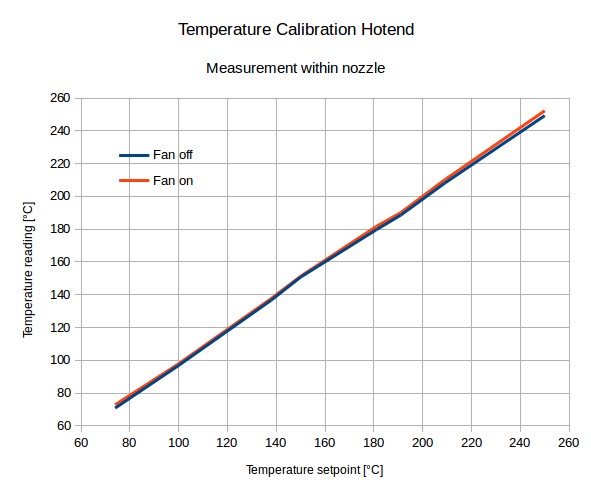Heizblock EPCOS
This modification was introduced as an intermediate check for the
temperature control using an NTC as temperature sensor.
Since the thermal interface between heater block and thermal sensor in the
original K8400 design is very unreproducible, I tried to use a PT 1000 as
temperature sensor. Unfortunately the resolution of the ADC of the ATMEL
chip is too poor for this configuration, the temperature reading has a lot
of noise.
So the solution for a reproducible and mostly correct temperature control is
the presented design. The Temperature reading is mainly impacted by the
accuracy of the thermistor and the sufficient usage of the proper thermal
grease between thermistor and heater block.
For the thermistor the EPOCOS 100K thermistor was selected.
The final assembly is shown in the picture below.

Using this design all features of the improved firmware can be used optimal.
This design is available as FreeCAD
file and PDF drawing.
Since a lot of K8400 are suffering the poor thermal control, I checked if I
can provide this part as a special service to all interested user.
The intended configuration would be:
1 pc. brass heat block with the design as presented
1 pc. EPCOS NTC 100K 1%
with soldered connection cable
1 pc. high temperature thermal grease (diamond powder based, approx. 1 gr
TBC)
1 pc. screw M3 for the nozzle fixing
1 pc. screw for T-Sensor fixation
A first estimation comes up with 50 Euro total cost + shipment. I would
start these activities after at least 20 fixed requests. The lead time for
the separate parts is approx. 3 weeks, I need up to 2 weeks for the final
assembly of the set.
Please use the given email address for contact.

In the meantime I had the chance to calibrate my temperature sensor, which
came along white a multimeter (Thermocouple Type K). First of all we were
surprised about he quite good temperature readings of this part (max 5°C
error between 60°C and 250°C). I did a temperature curve on the hotend,
while the sensor tip was in the nozzle itself (after unloading the
filament).
After the correction of the readings I was surprised about the results. The
overall temperature error was well within a range of 3°C, the impact of the
Fan could be reduced to this limit too. With this hotend configuration the
risk of clogged nozzle and, more important, the risk of burned isolator is
minimised.





